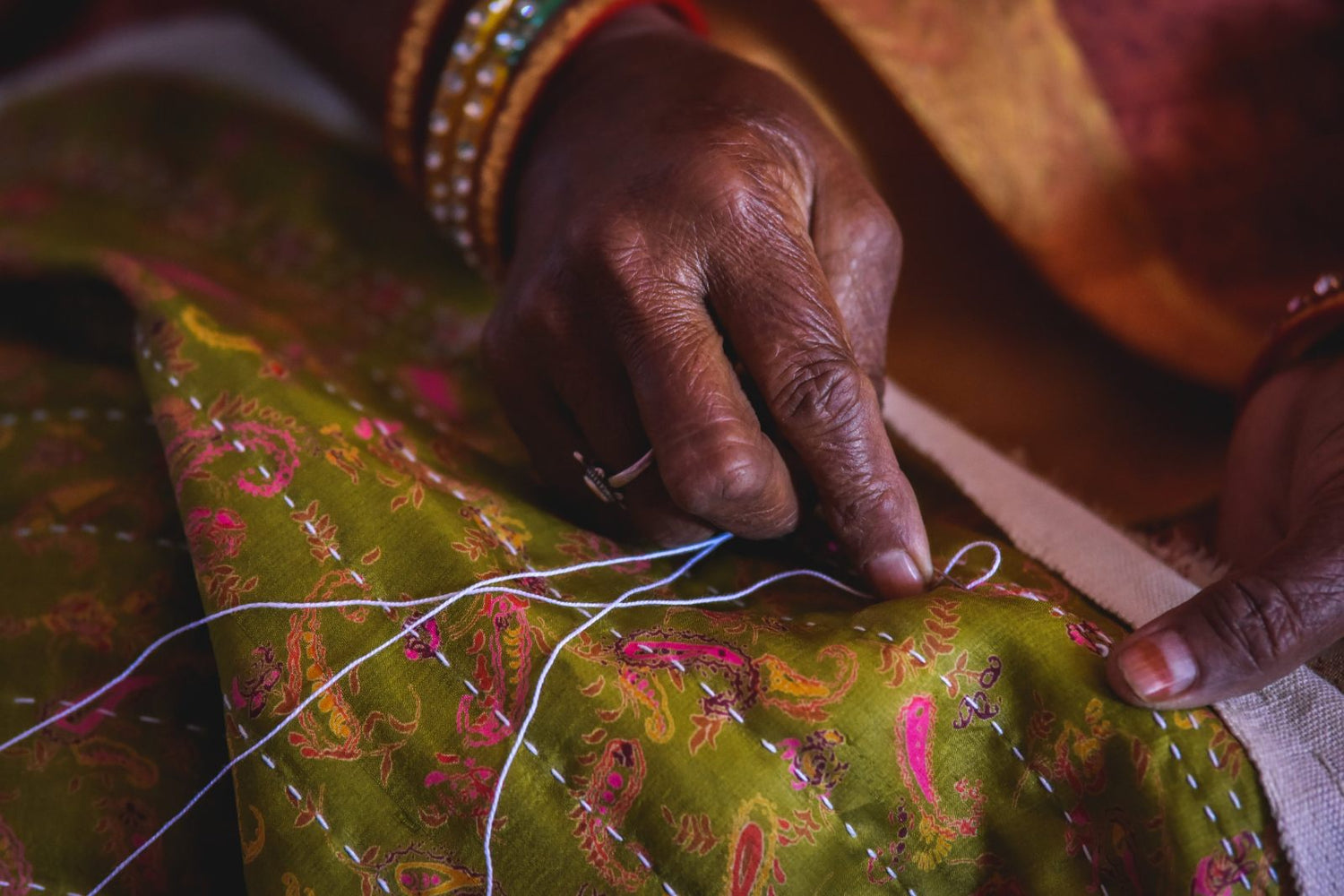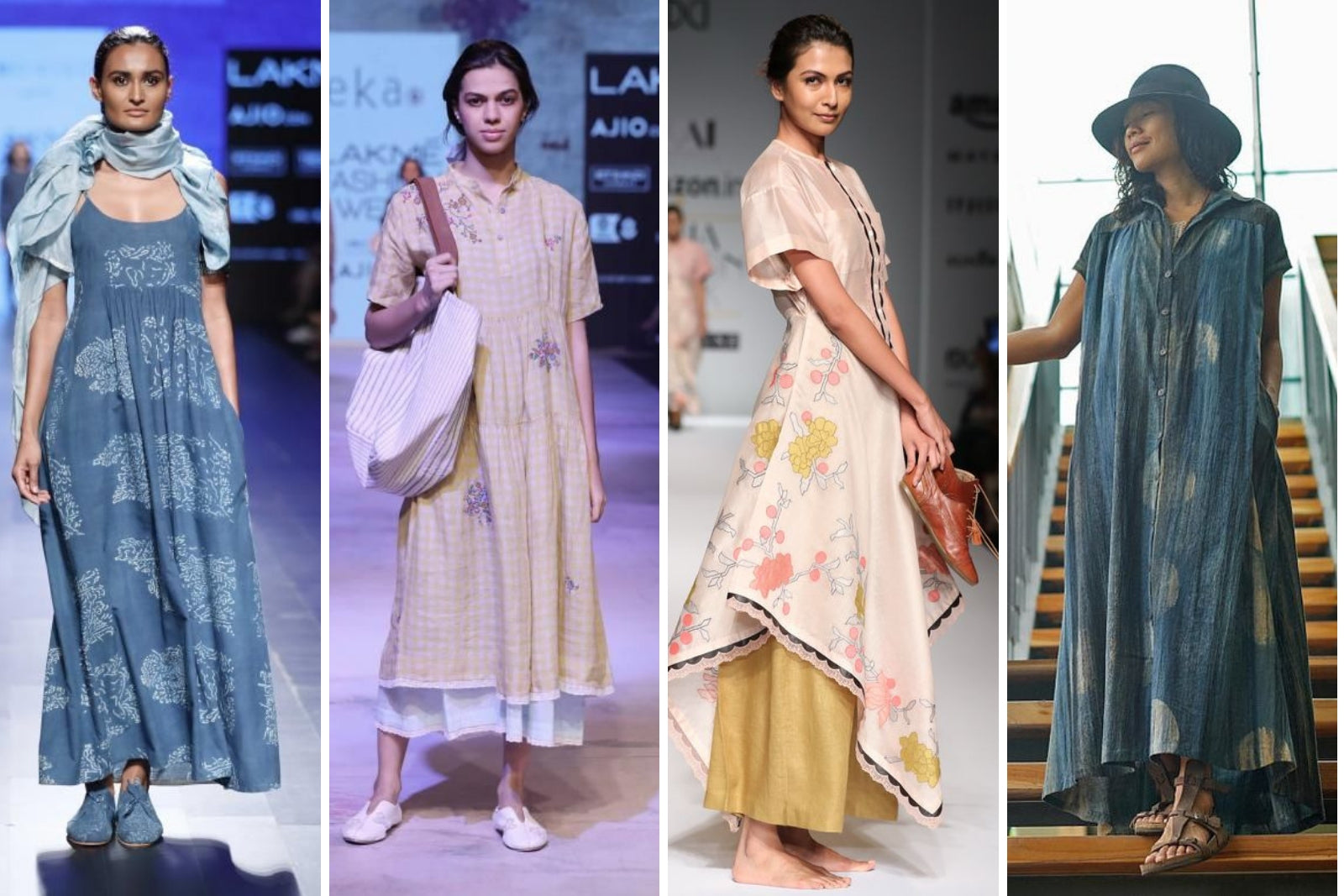A textile craft born and nurtured in parts of West Bengal, Odisha and Tripura, Kantha is one such embroidery technique, that has gathered love from not only west but the eastern artisanal community of India. Known to find its origin from women of ancient times, they started it more as a hobby to utilize old & waste fabrics; little did they know, that it will become a legend craft of all times.
Origin and History

The craft was taken up by the rich and poor alike, none of the end results lacked in the rustic beauty or the impeccable craftsmanship. Dating back to second A.D. Kantha work displays a variety of intricate motifs decorated with a running stitch. Taking in account the other meaning of Kantha- throat, the designs began with telling the tales of Lord Shiva consuming poison.
The initial idea behind Kantha was to turn old clothes into pure artefacts but gradually the love for the craft took over ethnic wear and home furnishing designs. From salwar suits, sarees, dupattas & skirts to cushion covers, bed sheets and quilts, the contrasting play of running stitch on cotton, silk, dobby and more fabrics, is extremely versatile and colorful in nature.
How Bengali Kantha found its way to Rajasthan

Embracing love from the artisanal community of Rajasthan, Kantha is a textile craft that unites two extreme corners of the country through yarns of similar interest and design ability. Gudari Kantha – a textile craft in which village women for ages have been utilizing katrans (waste or old fabric), by cutting and sewing it together and further adorning it with the Bengali Kantha is flourishing in various parts of Rajasthan like Choti Narena, Tilonia, Kotri, Bagru, Barmer and more. Because of the love this textile craft has gathered from across the globe, the artisans adopted it for a better source of livelihood along with continuing to excel in their niche, that is hand block printing.
Process

Kantha started with women stacking up worn out clothes and sewing them all together and then embroidered upon, now, however, it is practised on regular fabrics with white hues to enhance the brilliant embroidery. The motifs stretch to the realms of mythology, life at the village, as well as the whole spectrum of flora and fauna. Over the years it has taken up many forms and is now divided into seven distinct categories.
The most prevalent- Lep Kantha is used to make warm quilts, while Sujani Kantha for ceremonial bed covers. Exquisite book covers and other artefacts are made of Baiton Kantha. Archilata Kantha uses colourful motifs to decorate a mirror, on the other hand Durjani Kantha produces miniature pieces to line wallets. Oaar Kantha is used to create mesmerising pillowcases and Rumal Kantha covers plates with breathtaking motifs with Lotus as the centrepiece.
Faces behind the craft
Kantha is a predominantly female craft and has been passed down from one artisan daughter to another for ages. It is broadly practised by women in the districts of Hooghly, Burdwan, Murshidabad, North and South 24 Parganas and Birbhum of West Bengal. Bolpur- Shantiniketan is the production hub for Kantha sarees and Nakshi Kantha quilt. Muslim Kantha is well known for its geometric motifs and they reside in the Murshidabad, also in West Bengal.
One name that cannot be left without mentioning is Shamlu Dudeja, a revolutionary teacher of the craft who took great initiatives during the 80s to promote the artisan communities and pushed boundaries. Another such catalyst of the craft is Sushen Mukherjee who founded Amar Kutir Society in the heart of Birbhum district to efforts to provide a sustainable livelihood to the artisans of the region.
Kantha Apparels
After years of innovation and practice artisans can now achieve any garment, with uniting the age-old Kantha craft with modern silhouettes. Although it can take months to achieve the grace and perfection, the end results are simply worth the effort. You can easily spot Kantha work on dupattas, stoles, suits, sarees and more.
The authenticity of Kantha can be achieved on mostly all fabrics and designers have experimented with the craft quite a lot in the past few years to deliver some true masterpieces. Fusionistic sarees to patchwork Kantha jackets the runways have seen it all. Accessories are not uncommon, you can see some of the elitist sporting a Kantha handbag, neck and earpieces.
Home Furnishing & Decor
Kantha is a popular choice amongst the interior designer community, simply because of its ability to brighten a dull room as well as bring balance to the entire color scheme of a particular set up. We have talked a lot about the quilts and cushion covers but it is not limited to just that. Kantha can be seen on table mats, tea cozies, rugs and even furniture itself. This craft is so versatile that it can take the shape of an artist’s discrete imagination.
At Fabriclore.com, you will find a playful mix of mesmerizing machine-work Kantha fabrics done on a base of plain cotton, screen print and hand block varieties. Also, scout through our artisanal range of Handmade Gudadi Kantha Bedsheets and Pillow Covers crafted by artisans of Hatheli Sansthan.
Design your own traditional Kantha Ensemble and Share your design story with us at pr@fabriclore.com or tag us on Instagram - @fabriclore.
Authored By: Sunidhi Gaur
Follow us on:
Facebook: @Fabriclore
Instagram: @fabriclore




